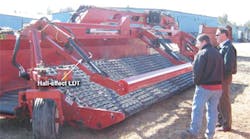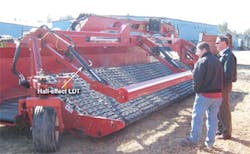Make hay while the sun shines is an old saying still in use, but it’s literal application became somewhat obsolete when lights on tractors and other farm equipment became commonplace. As with any modern process, making hay requires speed and repeatability for maximum productivity. Optimum speed and repeatability generally comes from automation, but agricultural equipment has not undergone the advantages of closed-loop control to the degree that machines on the factory floor have.
One of the challenges to automating agricultural equipment — or any type of mobile equipment, for that matter — is finding a effective and economical way of monitoring the stroke position of hydraulic cylinders. At one end of the spectrum are linear potentiometers. These sensors are relatively easy to incorporate into a cylinder and are somewhat inexpensive. However, the physical contact between a wiper and a conductive strip limits their life and performance.
At the other end are magnetostrictive sensors, which, generally, are mounted inside the cylinder. This requires boring a hole through the center of the cylinder’s piston and deep into the center of the piston rod. The procedure adds substantially to the cost and complexity of mounting the sensor. Therefore, this arrangement is practical for limited applications — primarily high-end equipment.
High-tech hay harvesting
Greg Landon, engineering manager at H&S Mfg. Co. Inc., Marshfield, Wis., was faced with this either-or situation once he decided to add closed-loop position control to H&S’s new windrow merger. After a field of alfalfa or other crop is cut, a hay merger is pulled through the field by a tractor. The merger contains two 15-ft wide merging heads, cross conveyors, and crop rollers. This combination is used to gather cut windrows of hay from the field and merge them into adjacent windrows.
The next step in the hay harvesting process is when a self-propelled forage harvester picks up, chops, and finally discharges the chopped hay into a forage transporter. From there, the hay is transferred into silos, where it will be compacted, stored, and eventually used as feed, usually for dairy cows.
Previous mergers produced windrows that were less uniform and consistent. This complicated the chopping process because the hay did not enter the chopper at a steady rate. The forage harvester is an expensive machine, so making consistent windrows pays off big by increasing the speed and effectiveness of the harvester.
The new merger from H&S features a closed-loop hydraulic system that adjusts to irregularities of the terrain. Its twin 15-ft sections work beside each other to direct cut hay on to an adjacent windrow, which will be to the right or left of the tractor.
As the merger is towed through a field, a series of teeth collect the hay and throw it onto a conveyer, which directs the hay into a uniform windrow. The crop roller is situated just above the teeth and makes the teeth operate more efficiently, thus increasing speed and ultimately improving the consistency of the windrow. The belt-crop roller style pickup is also gentler on the hay, which reduces leaf loss, thereby retaining more nutritional value in the feed..
The vertical distance between the teeth and the crop roller is critical in establishing the size, shape, and density of the windrow. As the merger is towed through a field, the head (which contains the teeth) must follow the contour of the ground in order to pick up all the hay. However, the crop roller — just above the teeth on the head — on th eprevious machine remains at a constant elevation. This means the gap between the teeth and the crop roller varies widely, so the windrow varies in height and density.
In the new merger, closed-loop hydraulics is used to keep the gap constant. This is accomplished with pairs of hydraulic cylinders that contain linear displacement transducers (LDTs) for position feedback. The LDT of one cylinder sends a signal to the merger’s electronic control to indicate elevation of the head. The control processes this signal and sends a signal to a cylinder controlling elevation of the crop roller. Feedback from this upper cylinder allows the control to maintain a consistent gap between the two machine elements. The cylinders are supplied by Energy Mfg., Monticello, Iowa, and are fitted with LDTs from Rota Engineering, Manchester, U. K.
A different approach
Rota Engineering’s design of LDT eliminates the need for a gun-drilled piston rod. It uses Hall-effect technology to sense the position of a magnetic piston through the barrel of a cylinder. A linear Hall-effect sensor positioned along the length of the cylinder barrel detects the position of the cylinder’s piston by sensing the position of a magnetic field formed by a permanent magnet embedded in the piston. As the piston rod extends or retracts, the magnetic field propagates through the cylinder wall to communicate with the linear Hall-effect sensor.
Several advantages stem from this approach:
- cost of achieving a smart cylinder is reduced by eliminating the need to gun-drill the piston rod,
- the cylinder is easier to assemble, install, and service,
- the permanent magnet in the piston should never need to be replaced,
- the external sensor is readily accessible and easy to replace if necessary,
- accuracy of the sensor is typically ± 0.5 mm (0.02 in) — more than adequate for most mobile equipment, and
- cylinder suppliers can manufacture cylinders with magnets so that end users can add stroke sensing functionality at a later time.
Sales engineer Scott Taylor, of Price Engineering, Hartland, Wis., served as system integrator for the project. He said Landon was first presented with a solution using a resistive-type LDT mounted alongside each cylinder. However, the externally mounted LDT had seals and moving parts that Landon thought might compromise the integrity of the control system. Mounting of this system was cumbersome and left the sensor susceptible to damage.
Price Engineering is a distributor for Energy Mfg., and Taylor figured the new technology offered by Rota Engineering might provide a preferable solution for Landon. For example, even though Rota’s LDT is mounted outside the hydraulic cylinder, it has no dynamic seals or moving parts that can be damaged by the ambient environment. Taylor also says the Hall-effect LDT also lends itself to the CAN-based control platform selected by Landon for the merger.
Closed-loop steering
The merger also features hydraulic steering, where a rotary sensor is used to determine the steering angle of the tractor-merger combination. The signal is monitored by the merger’s electronic control, which, in turn, sends signals to a proportional valve controlling position of the merger’s rear wheel steering cylinder. This cylinder also has Rota’s Hall-effect LDT in it for feedback to the control to ensure the rear wheels are positioned at an angle opposite that of the front wheels.
The closed-loop electrohydraulic merging control allows the operator to merge at much higher speeds than with conventional machines. Moreover, the multi-wheel steering gives the machine a much tighter turning radius, so much less time is spent maneuvering the machine after completing a windrow and repositioning it for the next pass.
For more information on Hall-effect LDTs, call Mark Hoffman at Rota Engineering's US office in Allen, Texas, at (972) 359-1041, e-mail [email protected], or visit www.rota-eng.com


